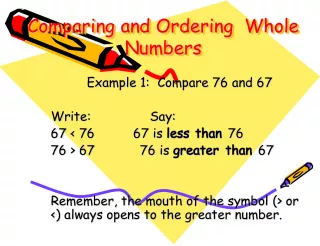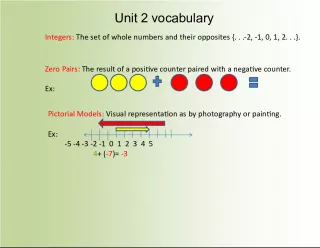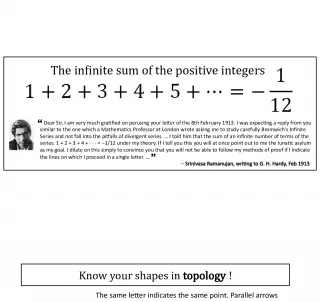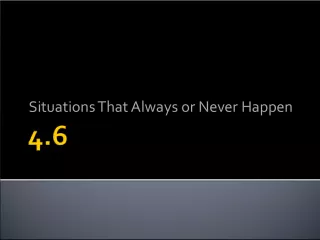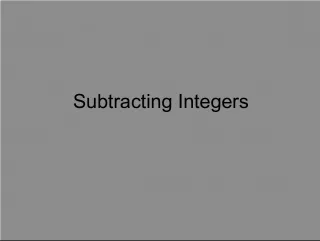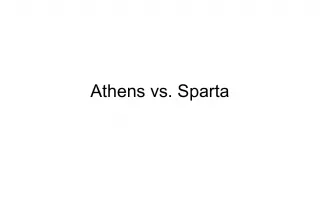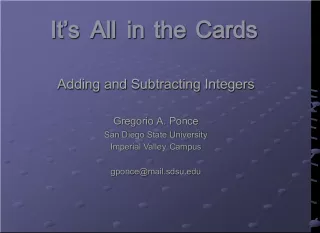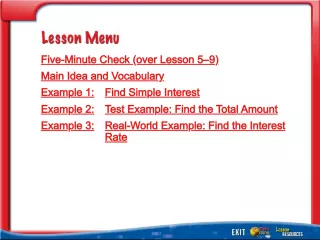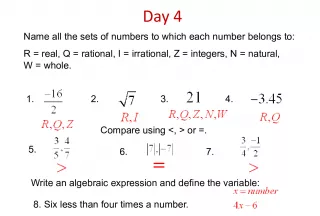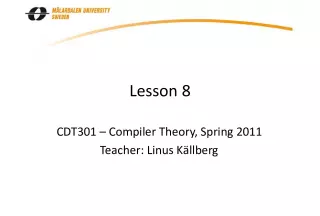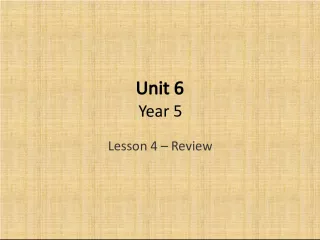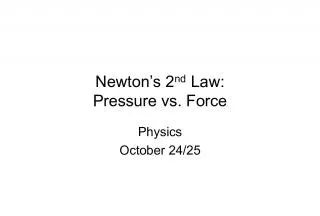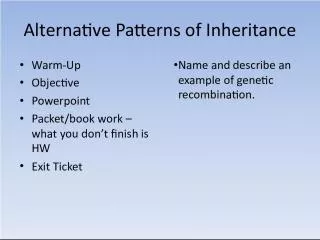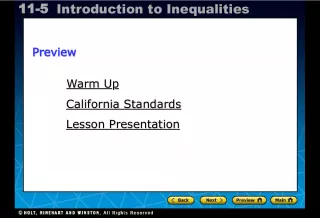Comparing Integers - Lesson 1


In this lesson, you will learn how to compare and order positive and negative fractions, decimals, and mixed numbers and place them on a number line as per California Standard Number Sense 1. You will also understand different types of numbers and their significance.
- Uploaded on | 0 Views
-
 ashtyn
ashtyn
About Comparing Integers - Lesson 1
PowerPoint presentation about 'Comparing Integers - Lesson 1'. This presentation describes the topic on In this lesson, you will learn how to compare and order positive and negative fractions, decimals, and mixed numbers and place them on a number line as per California Standard Number Sense 1. You will also understand different types of numbers and their significance.. The key topics included in this slideshow are Comparing Integers, California Standard, Number Sense, Number Line, Positive and Negative Fractions, Decimals, Mixed Numbers, Natural Number, Whole Number, Integer, Origin, Greater Than, Less Than,. Download this presentation absolutely free.
Presentation Transcript
1. 1 Lesson 1.1.1 Lesson 1.1.1 Comparing Integers Comparing Integers
2. 2 Lesson 1.1.1 Comparing Integers Comparing Integers California Standard: Number Sense 1.1 Compare and order positive and negative fractions, decimals, and mixed numbers and place them on a number line . What it means for you: Youll be able to arrange positive and negative numbers on the number line, and youll learn about different types of numbers. Key words: natural number whole number integer origin number line greater than less than
3. 3 Comparing Integers Comparing Integers This Lesson is about some of the different kinds of numbers you need to use, and how you can use the number line to put them in order. Lesson 1.1.1 The number line shows whether numbers are greater than or less than each other.
4. 4 Comparing Integers Comparing Integers The Number Line Shows the Order of Numbers The number line is a useful diagram that shows how numbers are ordered. Numbers to the right of 0 are positive . Lesson 1.1.1 Numbers to the left of 0 are negative . 0 is called the origin
5. 5 Comparing Integers Comparing Integers Example 1 To place 2 on the number line, count to the right of 0 by 2 steps. Lesson 1.1.1 Solution To place 8 on the number line, count to the right of 0 by 8 steps. To place 12 on the number line, count to the right of 0 by 12 steps. 2 8 12 Arrange the numbers 2, 8, and 12 on the number line. Solution follows
6. 6 Comparing Integers Comparing Integers Lesson 1.1.1 You always count in steps from 0, but if its a negative number then remember to count to the left . Dont Forget
7. 7 Comparing Integers Comparing Integers Example 2 To place 5 on the number line, count to the left of 0 by 5 steps. Lesson 1.1.1 Solution To place 3 on the number line, count to the right of 0 by 3 steps. To place 7 on the number line, count to the right of 0 by 7 steps. To place 3 on the number line, count to the left of 0 by 3 steps. 7 3 3 5 Arrange the numbers 3, 5, 3, and 7 on the number line. Solution follows
8. 8 Comparing Integers Comparing Integers Guided Practice Solution follows Lesson 1.1.1 1. Arrange the numbers 3, 4, 1, and 8 on the number line. 1 3 4 8
9. 9 Comparing Integers Comparing Integers Guided Practice Solution follows Lesson 1.1.1 Say which side of the origin the numbers in Exercises 25 would go on. 2. 23 3. 9 4. 6 5. 1 Origin the left the right the left the right
10. 10 Comparing Integers Comparing Integers The Number Line Lets You Compare Numbers If two numbers are plotted on the number line, then the number to the left is less than the number to the right . There are two important symbols used to order and compare two numbers. The symbol > means greater than and the symbol < means less than . Lesson 1.1.1 You could also say that the number to the right is greater than the number to the left . 4 3
11. 11 Comparing Integers Comparing Integers Example 3 By placing them on the number line, show that 1 is greater than 4. Solution follows Lesson 1.1.1 4 1 1 is to the right of 4, so 1 > 4 . To place 4 on the number line, count to the left of 0 by 4 steps. To place 1 on the number line, count to the right of 0 by 1 step. Solution
12. 12 6. 7 3, so is greater. 7. 2 3, so is greater. 8. 1 10, so is greater. Comparing Integers Comparing Integers Guided Practice Solution follows Lesson 1.1.1 In Exercises 68 fill in each box with the correct < or > symbol, then say which number in each Exercise is greater. < 7 3 10 > <
13. 13 Comparing Integers Comparing Integers Guided Practice Solution follows Lesson 1.1.1 In Exercises 911 fill in each box with the correct < or > symbol, then say which number in each Exercise is greater. 9. 8 0, so is greater. 10. 9 11, so is greater. 11. 1 1, so is greater. > < 0 9 1 <
14. 14 Comparing Integers Comparing Integers Whole and Natural Numbers Are Types of Integers Youve already been dealing with different types of numbers on the number line now its time to learn their names. Integers include all the natural numbers , the negative versions of them, and zero. Lesson 1.1.1 Whole numbers are like the natural numbers except that they include the number zero . Natural numbers are also called counting numbers because theyre the numbers used to count with 1, 2, 3, and so on.
15. 15 Comparing Integers Comparing Integers Example 4 1. 1 is greater than zero so it is a natural number . All natural numbers are also whole numbers and integers . Solution follows Lesson 1.1.1 Solution Describe the following numbers as natural, whole, or integer. There may be more than one answer for each. 1. 1 2. 0 3. 3 2. 0 is not a natural number, but it is a whole number . As it is a whole number it is also an integer . 3. 3 is less than zero so it is not a natural number and not a whole number. But it is an integer .
16. 16 Comparing Integers Comparing Integers Guided Practice Solution follows Lesson 1.1.1 Describe each number as a natural number, a whole number, or an integer. There may be more than one answer for each. 12. 7 13. 9 14. 400 15. 1 16. 55 integer, natural number, whole number integer integer integer, natural number, whole number integer, natural number, whole number
17. 17 Comparing Integers Comparing Integers Guided Practice Solution follows Lesson 1.1.1 Describe each number as a natural number, a whole number, or an integer. There may be more than one answer for each. 17. 0 18. 26 19. 16 20. 32 21. 3.2 integer, whole number integer, natural number, whole number integer integer not an integer, natural number, or whole number
18. 18 Comparing Integers Comparing Integers Independent Practice Solution follows Lesson 1.1.1 1. Place 3, 1, 5, and 2 on a number line. Answer each of Exercises 29 as true or false. 2. 4 < 9 3. 23 > 40 4. 0 < 1 5. 1 > 2 6. 4 > 5 7. 0 is a positive number. 8. Whole numbers can be negative. 9. All integers are whole numbers. true false 3 true false true false true false 2 1 5
19. 19 Use this number line to help answer Exercises 1113. 11. How many natural numbers are between 3 and 5? 12. How many whole numbers are between 3 and 5? 13. How many integers are between 3 and 5? Comparing Integers Comparing Integers Independent Practice Solution follows Lesson 1.1.1 10. Hector is thinking of a number that is a whole number but is not a natural number. What number is Hector thinking of? 0 4 5 7
20. 20 Comparing Integers Comparing Integers Lesson 1.1.1 Round Up Round Up Thinking in terms of the number line is a good way to compare integers so you can say which is greater than the other. It also helps you to understand what happens when you add positive and negative numbers, which is all part of the next Lesson.

